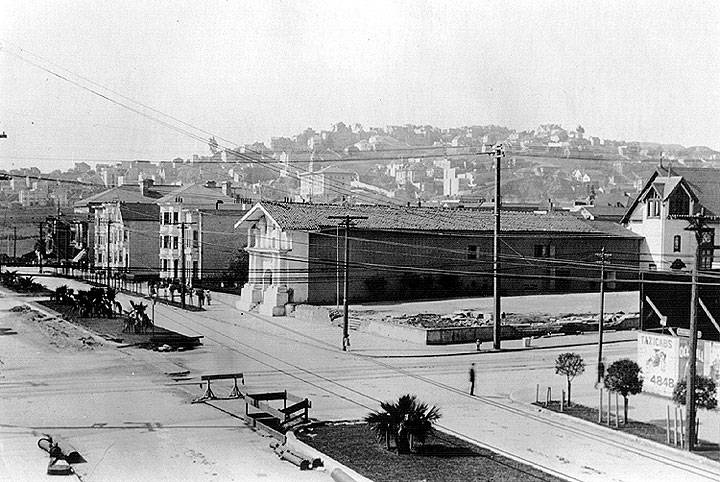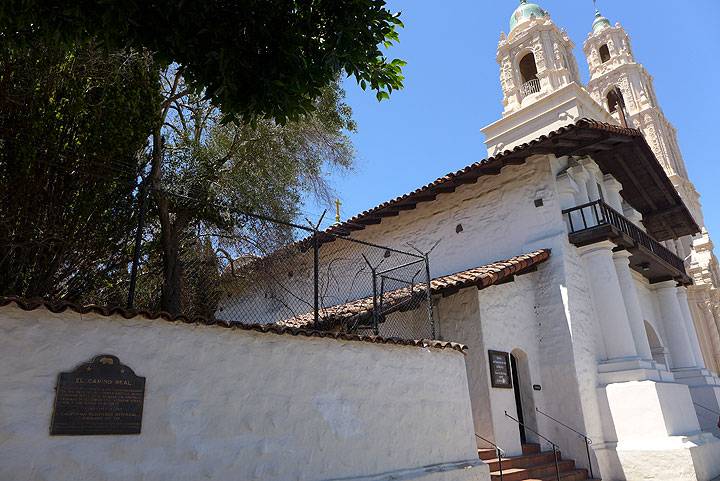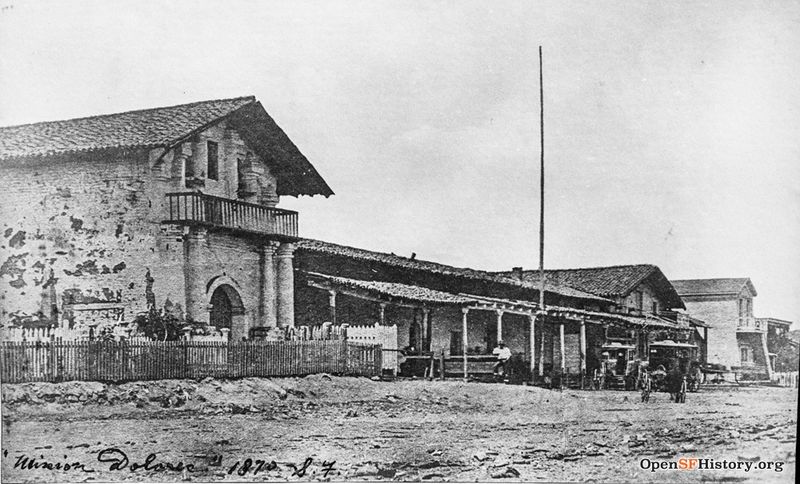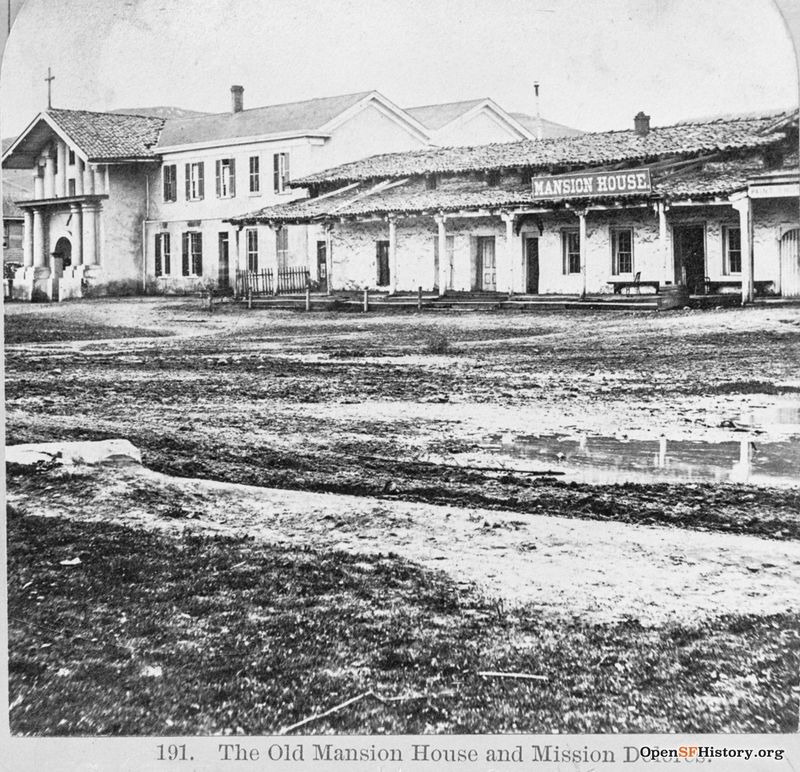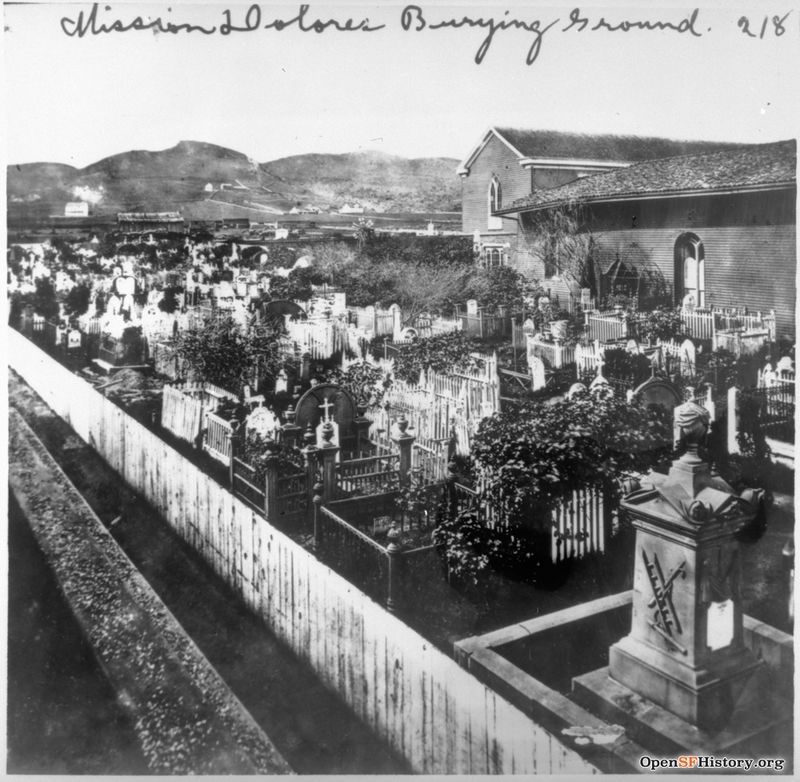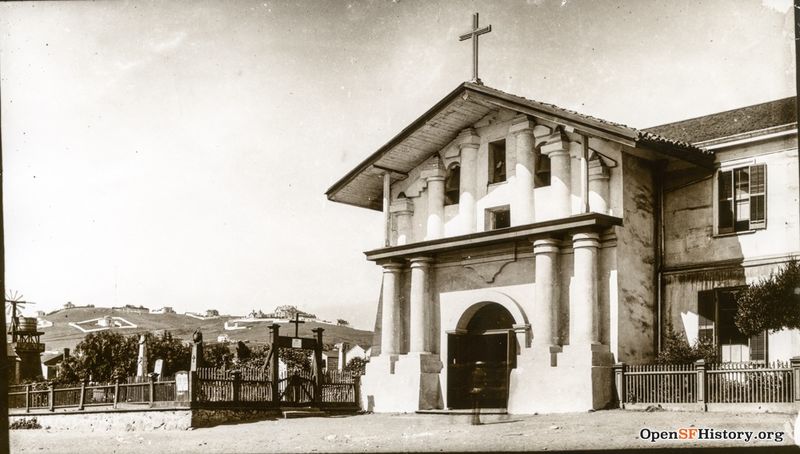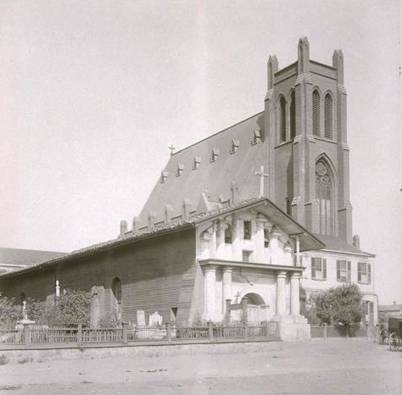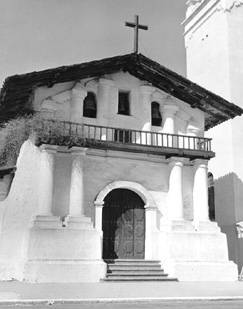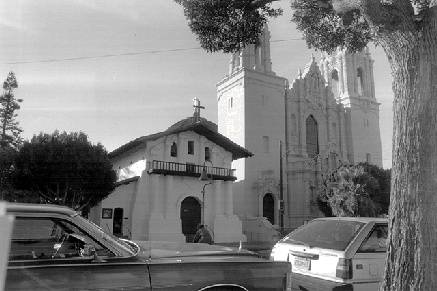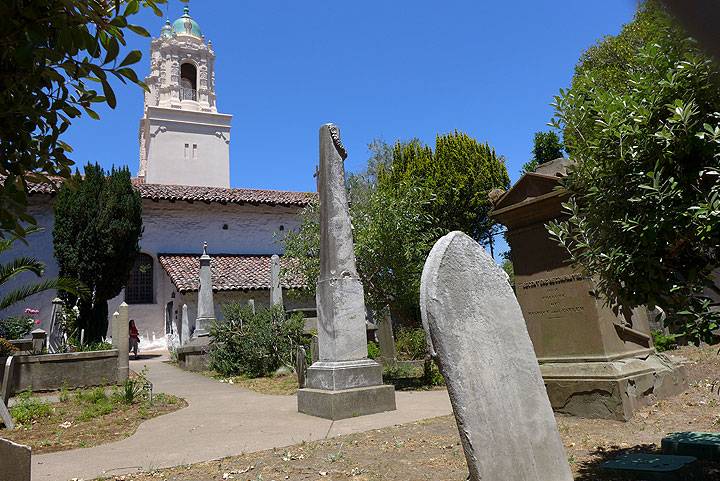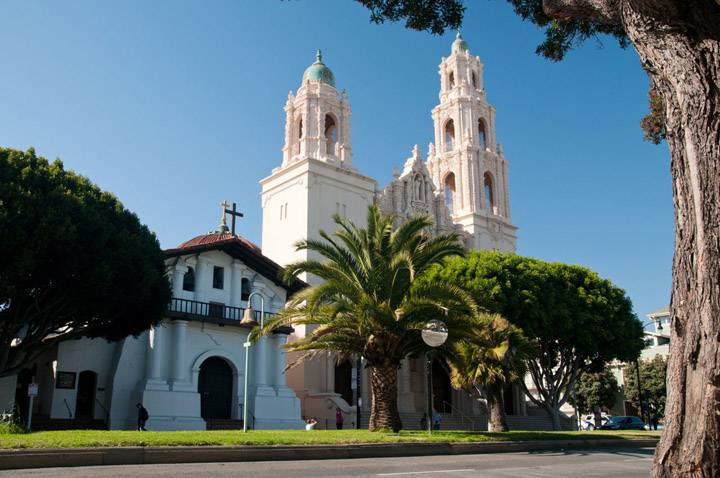Mission Dolores
Historical Essay
by Br. Guire Cleary, S.S.F
Mission Dolores c. 1912.
Photo: Shaping San Francisco
Mission Dolores, 2017.
Photo: Chris Carlsson
SAN FRANCISCO—EXPLORATION AND FOUNDATION
San Francisco's oldest intact building is the principal remaining physical monument of the Spanish Empire and Mexican Republic in the region of the San Francisco Bay. The mission is named after the founder of the Franciscan Order, Saint Francis of Assisi (1182-1226). Founded under the direction of Fray Junípero Serra, it is the sixth Franciscan mission to be established in Alta California. A story is recounted by California's first historian and the first Franciscan pastor of Mission Dolores, Fray Francisco Palóu about the naming of San Francisco. In 1768 José de Gálvez, the Inspector General of Mexico, informed Junípero Serra of the names to be given to the missions to be established in Alta California. Serra remonstrated saying, "Is there then to be no mission for Our Father San Francisco?" Gálvez jested, "If San Francisco wants a mission, let him cause his port to be discovered, and it will be placed there!" It was not until Sergeant José Francisco Ortega, under command of Gaspár de Portolá, sighted the Golden Gate and the San Francisco Bay on November 1, 1769 that Europeans became aware of the existence of the immense bay and its beautiful passage through the coastal mountains. San Francisco had led Spain to its port.
In 1774, an expedition led by Captain Fernando Rivera y Moncada began explorations for a suitable site for the mission of San Francisco. Accompanying the expedition was Fray Francisco Palóu. Presents were made to Ssalson Ohlone people of beads and Spanish food, including wheat and beans. Palóu records in his diary that the Indians were much taken with the products of European culture and Palóu promised that he would return and help the First Peoples to plant seeds and gather them in great abundance. Palóu believed that the Ohlone were pleased, understood him and would help build houses when he returned to establish a mission.
Viceroy Antonio Maria Bucareli y Ursúa, concerned about the possibility of Russian encroachment on what he held to be Spanish territory, ordered Captain Juan Bautista De Anza to recruit soldiers and settlers in Sonora, Mexico and establish a Mission and Presidio in the port of San Francisco. Mission San Francisco de Asís has as its common name "Mission Dolores," taken from the name of the now vanished Lake Dolores and Dolores Creek. The Señor Commandante, Colonel Juan Bautista de Anza, who explored the creek and lake on the Friday before Palm Sunday, April 5, 1776, gave the name "Dolores". This day was traditionally called the Feast of Our Lady of Sorrows (Nuestra Señora de los Dolores). On June 27, 1776 the colonists under the command of Lieutenant José Joaquin Moraga arrived along the shore of Laguna Dolores, near what is now Albion and Camp Streets in the Mission District. Two Franciscan padres, Fray Francisco Palóu and Fray Benito Cambón, accompanied them. Under an arbor (enramada) built by Moraga's soldiers, Fray Francisco Palóu celebrated the first Mass on the feast of Saints Peter and Paul, June 29, 1776. [Much innocent ink has been spilt over the issue of whether this date of June 29, 1776 is the "official birthday" of the mission and of the city of San Francisco. The author of this article is inclined to October 9, 1776 as the ecclesial dedication of the mission church, but is prepared to celebrate all reasonable dates and solicits invitations to all parties commemorating same.] Moraga's soldiers remained about a month and withdrew to found the Royal Presidio near the Golden Gate.
MISSION SAN FRANCISCO—GOALS AND PURPOSES OF THE MISSIONS
Fray Junípero Serra was a philosopher of the school of John Dun Scotus who believed that God is love and that this love is manifested within communities and relationships. The effort of missionization was to create Christian communities where God would be revealed. Central to the goals of the Franciscans at Mission Dolores was the idea of ingathering of native peoples into villages (reducion), inculcation of Christian doctrine and morality, and European cultural values, establishment of Spanish law and government, and the creation of townships of Hispanicized farmers and artisans out of the indigenous population. Spanish law guaranteed that Indian tribes entering the mission system would have their lands preserved intact under the management of the mission padres. The intention was to have self-governing pueblos in place within 10 years. This was the plan and hope of missionization: that Indians would be attracted by European technology and culture and, establishing their homes near missions, would ultimately accept Christianity and Spanish rule. The labor, creativity, and skills of the Indians of the Bay Area created an astonishingly complex ranching, agricultural, and manufacturing enterprise at Mission Dolores and the other missions of California. While the process of conversion to Christianity was mostly voluntary, once baptized an Indian became the ward of the mission and subject to what to our era must appear to be oppressive and controlling in the extreme.
MISSION SAN FRANCISCO—ESTABLISHMENT AND GROWTH
The missionaries turned their attention to the establishment of the mission and the conversion of Ohlone Indians in the nearby village of Chutchui. Palóu inscribed the register of the mission on August 1, 1776 with the words, "…the Mission of Our Father San Francisco, founded by Religious of the holy Apostolic College of San Fernando at this Port of the same name of our Father San Francisco in Northern California, through the favor and at the expense of our Catholic Monarch, the King of Spain, Don Carlos III…commenced at the same time that it was founded in the vicinity of the new presidio of the same name of San Francisco…" The mission was formally opened on October 9, 1776. The first adult Indian baptism took place on June 24, 1777 when Chamis, a 20-year-old Ohlone man, was baptized and given the Christian name of Francisco Moraga. Lieut. José Joaquin Moraga acted as godfather. Chamis later became the first Indian married at Mission Dolores, taking Paszém as his wife on April 24,1778.
Several temporary chapels were built at Mission Dolores and the foundation stones of the present mission church were laid in 1783. Some 26,000 adobe bricks were made by 1788, and the walls were largely in place by the end of that year. The church was dedicated on August 2, 1791, making it the oldest intact church nave in California. Roof tiles were laid on in 1794-1795. Within a few years, other adobe buildings were added for housing, ranching, agricultural, and manufacturing enterprises. At its peak in 1810-1820, the average Indian population at Pueblo Dolores was about 1,100 persons. The California missions were not only houses of worship. They were farming communities, manufacturers of all sorts of products, hotels, ranches, hospitals, schools, and the centers of the largest communities in the state. Gov. Figueroa said of the California missions in 1834, "Military and civilians depended on missions, (which) made loans, hostels where travelers and poor received food, lodging, horses, or whatever they wanted free of charge. California missions were the sole source of the prosperity of the territory." Mission Dolores at the peak of its prosperity in 1810 owned 11,000 sheep, 11,000 cows, and thousands of horses, goats, pigs, and mules. Its ranching and farming operations extended as far south as San Mateo and east to Alameda. Horses were corralled on Potrero Hill, and the milking sheds for the cows were located along Dolores Creek at what is today Mission High School. Twenty looms were kept in operation to process wool into cloth. The circumference of its holdings was said to have been about 125 miles.
Setbacks at Mission Dolores included a mass exodus of 280 people in the summer of 1795 due to the three muchos: too much work, too much punishment, and too much hunger. Periodic epidemics of measles, smallpox, and diphtheria drastically reduced mission populations. Syphilis and bacterial infections took immense tolls. Padre Ramon Abella recorded the following sad note in the Burial Register at Mission Dolores on July 22, 1814, "Today I buried Viridiana, the last of the adults who witnessed the founding of the mission…Everyone who saw the arrival of the missionaries…have died; and of those who have been born since that time, rare are those who live." The imposition of a communal labor and living system on the native population made possible exposure to European technology, resources, and commerce but at a cost that still engenders debate. Many hold that the majority of the padres were selfless and motivated by religious and humanitarian goals. However, the results are questioned and still vigorously debated. By 1810 more than 5,000 years of tribal life in the Bay Area had effectively ended. Government support of the military in Alta California ceased with the inception of the Mexican War of Independence in 1810.
Tensions and disputes arose between the missions and the civil authorities when the missions were asked to supply food and manufactured goods to the military. After the Mexican Republic was established in 1821, pressure began to mount for the close of the missions. Politicians of the day debated whether lands and enterprises under mission custody would be acknowledged as owned by the Indian Christians and organized into townships or largely redistributed to the Mexican settlers. In 1834, Mission Dolores was ordered to be turned over to an administrator who valued the holdings at $67,227.60. The process of secularization meant that the missions would no longer manage the agricultural, ranching and manufacturing enterprises with their vast holdings of land and livestock. The missions would essentially be made into parish churches consisting of only the church proper, the residence of the priests and a small amount of land immediately surrounding the churches for use as kitchen gardens and cemeteries. By 1842, there were only eight Indian Christians resident at the mission. Spiritual needs of the parish were met by remaining Franciscans, but the situation of the parish was doubtful, and the last Franciscan, Fray José Real, withdrew to Santa Clara in 1845.
MISSION DOLORES—POST-FRANCISCAN HISTORY
By 1856, the Mission had fallen into disrepair.
Photo: OpenSFHistory.org wnp37.02910
The period 1835 to 1846 was an uncertain time for the now secularized missions of Alta California. Most of the buildings in the compound of Mission Dolores were taken over for secular purposes. The building of two plank roads from Yerba Buena to the Mission District in the 1850s allowed easy access to what became an entertainment district. Bull and bear fights, gambling, drinking, and other entertainments became a feature of the place, although the mission church continued as a place of prayer. Some of the buildings were turned into a hospital, German brewery, saloons, gambling hall, etc. The acquisition of Alta California by the United States of America began an investigation into the land claims asserted by the Mexicans. Most of these claims had been carved out of what had previously been mission holdings. Much of the immediate land of the mission became part of Rancho San Miguel, owned by the Noe family. On March 3, 1851, President James Buchanan confirmed some four acres of the original immense holdings of Mission Dolores to Bishop Alemany. On March 18, 1848, one of San Francisco's most prominent citizens, William Alexander Leidesdorff, died and was laid to rest inside the mission church. Most of San Francisco's population of some 400 were said to have attended the burial.
Mission Dolores and Mansion House, 1866.
Photo: OpenSFHistory.org wnp37.00602-R
Mission Dolores cemetery, c. 1868.
Photo: OpenSFHistory.org wnp71.1458
Mission Dolores, c. 1880.
Photo: OpenSFHistory.org wnp27.4089
Dolores and 16th, c. 1885.
Photo: OpenSFHistory.org wnp37.01651
Mission Dolores (Church and Mission). Ca. 1898
Photo: The Bancroft Library. University of California, Berkeley
Within two years the population had grown to more than 25,000. Many of the Argonauts were Irish, French, and German Roman Catholics and the burial registers show a change from predominately Spanish names to Irish. In honor of the centennial of San Francisco in 1876 and to accommodate a growing population, Mission Dolores dedicated a new red brick Victorian neo-gothic church. The erection of a modern church next door to the old mission allowed for the adobe church and its Spanish era art to be preserved, or at least largely forgotten except as a relic of the past. On April 18, 1906, a major earthquake that created fires that heavily ravaged the Mission District struck San Francisco. In an effort to save Mission Dolores from destruction, firefighters dynamited the Convent and School of Notre Dame across the street from the mission church. Later this was thought to have been unnecessary. While the adobe structure survived, the red brick church was structurally compromised and torn down. Some 23 square blocks of the 46 square blocks comprising the parish of Mission Dolores were destroyed on April 18-20, 1906. A temporary church was erected along 16th Street.
Noted San Francisco architect Willis Polk supervised a sensitive retrofitting and restoration of the adobe church in 1917. Foundations for a new parish church of steel and concrete were laid in 1913 and the first Mass was held on Christmas Day 1918. World War II saw many changes in the parish. Its Irish population relocated, and increasingly the parish served a largely Latin American population. On February 8, 1952, Pope Pius XII raised the church to the honor of a Minor Basilica. Mission Dolores became the first church designated a basilica west of the Mississippi River and only the fourth to be so honored at that time. On September 17, 1987, Pope John Paul II became the first reigning Roman Pontiff to visit San Francisco and pray at the Basilica. Particularly memorable and moving was his embracing of a child with AIDS. Another earthquake in 1989 occasioned a major campaign for retrofitting, strengthening and conservation. The cemetery and the artwork of the old mission church were restored to period appearance in 1995.
MISSION DOLORES - PHYSICAL DESCRIPTION
Mission Dolores c. August 14, 1956
Photo: San Francisco History Center, San Francisco Public Library
By 1995, Mission Dolores was proudly restored, and a major tourist destination.
Photo: David Green
The mission church we see today is a rectangular adobe building 114 feet long, 22 feet wide, and 21 feet high from floor to ceiling. The walls are four feet thick, except for the walls facing Dolores Street, which are ten feet thick. It is thought that the mud for the adobe was taken from the banks of Dolores Creek about where Dolores and Dorland Streets are today. The foundations are four feet wide and four feet deep and said to be of stones quarried from Mint Hill. In the front wall (fachada) of the mission are three niches containing the three original bells brought up from Mexico in the 1790s. The names of the bells, from south to north are San Martin, San Francisco and San Jose. The central bell is in its original wooden stocks secured by rawhide. Many of the roof tiles are the originals made on site in 1794. Mission Dolores is particularly famed for its artwork. Most of the paintings were imported from Mexico before the Revolution of 1810. The principal ornaments are the altars, statues and reredos. The principal altar was brought by ship from Mexico in 1796, while the two side altars followed in 1810.
The U.S. Department of the Interior in its Historic American Buildings Survey of 1936 said of the interior decoration, "It is a most extraordinary piece of Spanish Baroque decorative art, possibly without equal in North America outside of Mexico." The principal altar is fashioned in Baroque taste, while the side altars reflect an Enlightenment period taste with a more severe neoclassical style. Also notable are the ceiling rafters decorated in an Ohlone motif of ochre, white, red, and blue/gray colored chevrons. Comparisons have been made to similar motifs in Ohlone basket work. The holy water fonts at the back of the church are Chinese plates brought to California on the Manila Galleons in the 18th century. The standing candlestick in the sanctuary is of Ohlone manufacture. Among the most interesting 18th century Mexican paintings is an oil painting of "Our Lady and the Christ Child Arriving to the New World." Sometimes this painting has been humorously called "Our Lady Sailing through the Golden Gate."
The parish church, commonly called the Basilica, was dedicated on Christmas Day 1918. Architects Frank T. Shea and John O. Lofquist designed the new parish church in the California Mission style and of concrete and steel to withstand earthquakes. Decoration of the new church continued for another 15 years and included much Baroque Mexican architectural embellishment. This work, under the direction of architect Henry Minton, was undertaken for the celebration of San Francisco's sesquicentennial in 1926. Particularly noteworthy are the interior mosaics and stained glass windows depicting the 21 Franciscan missions of Alta California executed by the Meyer Company of Munich. Considerable care went into the design of the art and a letter from the Meyer Company to the pastor, Rev. Andrew B. Abrott, complained that each window had been redesigned once or twice and that the devalued American dollar made the project a "sour deficit." The Basilica, in addition to being a place of prayer and pilgrimage, is a performance venue for such renowned groups as the Coro Hispano de San Francisco, Conjunto Neuvo Mundo, and Chanticleer.
MISSION DOLORES CEMETERY
The last cemetery still within San Francisco city limits, 2017.
Photo: Chris Carlsson
Mission Dolores cemetery, with re-created Ohlone hut in background.
Photo: Chris Carlsson
Mission Dolores contains one of the two remaining cemeteries within the city limits of San Francisco. The first burial at Mission Dolores was that of a nine-year-old daughter of the soldier Francisco Alvarez in 1777. The last burial was 1898. The original burial site was some three times larger than the now existing site and there has been some consolidation and removal of remains. Although there are only about 200 existing headstones, some 10,000 people were buried here, of whom some 5,000 were Indians. Notable burials in the cemetery include early colonial families such as Noe, Sanchez, and Bernal. Luis Antonio Arguello, the first Mexican governor of Alta California, and Francisco de Haro, the first alcalde, are buried close to each other. The cemetery is also the final resting place of three victims of the Committee of Vigilance, James "Yankee" Sullivan, Charles Cora, and James Casey. Inside the mission church are buried Lt. Moraga, Rev. Richard Carroll, William Leidesdorff, and three members of the Noe family. The Noes owned Rancho San Miguel, which extended over a considerable area of Noe and Eureka Valleys.
The body of the founder of the Mission and Royal Presidio of San Francisco, Lieutenant Jose Joaquin Moraga, was laid to rest in the previous mission church after his death on July 13, 1785. So deeply was he esteemed by the Franciscans that when the current church was dedicated in 1791, Moraga's body was reinterred inside the mission close to the altar. As Padre Palóu recorded in the Burial Register, "The remains of the body of Don Jose Joaquin Moraga, founder and captain commander of the neighboring Presidio and of this establishment of our Father Saint Francis, were transferred from the old church to the new one, with all the pomp that was possible and becoming to his merits." These and other handwritten documents and manuscripts are still preserved at Mission Dolores.
MISSION DOLORES—TODAY
Mission Dolores and the Parish, 2013
Photo: Kathleen Yago
While the merits and justice of the mission system are still a matter of debate, the centrality of the missions to California history has never been questioned. Mission Dolores was the meeting place between the First Peoples and the Spanish Empire and Mexican Republic. The ramifications of the Encounter (encuentro) are still playing out whenever San Franciscans attempt to make sense of their identity or history as a community. Mission Dolores continues as an active parish of the Roman Catholic faith. Mission Dolores Elementary School serves some 233 children. The year 2001 marked the designation of Mission Dolores as a Jubilee Pilgrimage site and the 225th anniversary of its establishment. In celebration of these events Ohlone descendants were invited to plant specimens of culturally significant flowers, shrubs, and herbs. A traditional tule reed house was also erected. The Native Sons of the Golden West placed a plaque on the wall of the mission paying tribute to the Ohlone Nation as the founders and builders of the mission and this community, thus making Mission
Dolores one of the very few colonial places in California explicitly memorializing the contributions of the First Peoples. Mission Dolores has been recognized as a landmark by both the City of San Francisco and the State of California. The Old Mission welcomes thousands of tourists, visitors, pilgrims and school children every year. Its beauty has captured the imagination of poets (Bret Hart, "The Bells of Mission Dolores"), filmmakers (Alfred Hitchcock, "Vertigo"), rock musicians (Jerry Garcia, "Mission in the Rain"), shipbuilders (S.S. Mission Dolores and S.S. Mission San Francisco), and tens of thousands of people wishing to take in the beauty of its architecture and art, the peace inside its walls and cemetery, and the continuous history of living the Franciscan motto, "La Paz y Bien," Peace and All Good.
Mission Dolores is located at the corner of 16th and Dolores Streets. The mailing address is 3321 16th Street, San Francisco, CA 94114. Visiting hours are seven days a week, 9:00 a.m. to 4:00 p.m. (4:30 p.m. in the months of May through October). The mission is closed on some holidays. Visit the website for days of closure, listings of special events and obtaining information packets for school reports. Telephone: 415-623-8206. Telephone the curator for information on tours, history, and volunteer opportunities.
Bibliography
—Bancroft, Herbert H. History of California. Santa Barbara: Wallace Herberd, 1963.
—Bolton, Herbert Eugene. Font's Complete Diary. A Chronicle of the Founding of San Francisco. Berkeley: University of California Press, 1933.
—Englehardt, OFM, Zephyrin. San Francisco or Mission Dolores. Chicago: Franciscan Herald Press, 1924.
—Cleary, S.S.F., Guire. "Franciscan Sunset at Mission Dolores." The Argonaut, Volume 12, No. 2 (Winter 2001).
—Cowan, Robert Ernest. Mission Dolores. San Francisco: Eureka Press, 1916.
—Davis, John F. The Founding of San Francisco, Presidio and Mission. San Francisco: Pernau-Walsh Printing Co., 1927
—Graham, Mary (editor). Historical Reminiscences of One Hundred Years Ago. The Mission San Francisco de Asís. San Francisco: P. J. Thomas, 1876.
—Guilfoyle, Merlin J. Dolores or Mission San Francisco. San Francisco: Dolores Press, 1965.
—Hutchinson, C. Alan. Frontier Settlement in Mexican California. New Haven: Yale University Press, 1969.
—Johnson, Paul C. (editor). The California Missions: A Pictorial History. Menlo Park: Lane Book Company, 1964.
—Langellier, John Phillip and Rosen, Daniel B. El Presidio de San Francisco: A History Under Spain and Mexico, 1776-1846. Spokane: Arthur H. Clark Co., 1996.
—McCumsey, Robert. California Missions: Measured Drawings. Historic American Buildings Survey. San Luis Obispo: Learning Windows Publications, 1999.
—Merrill, George A. The Story of Lake Dolores and Mission San Francisco de Asís. Redwood City: The Hedge Printing Co., 1942.
—Millikin, Randall. A Time of Little Choice. Menlo Park: Ballena Press, 1995.
—O'Kane, Thomas. Sermon on the Occasion of the 160th Anniversary of Mission Dolores. San Francisco: Monitor Publishing Co., 1936.
—Portman, Frank. "Pedro Benito Cambón, OFM: Mission Builder Par Excellence." The Argonaut, Volume 5 No. 2 (Fall 1994).
—Webber, Francis J. Mission Dolores: A Documentary History of San Francisco Mission. Hong Kong: Libra Press. 1979.

